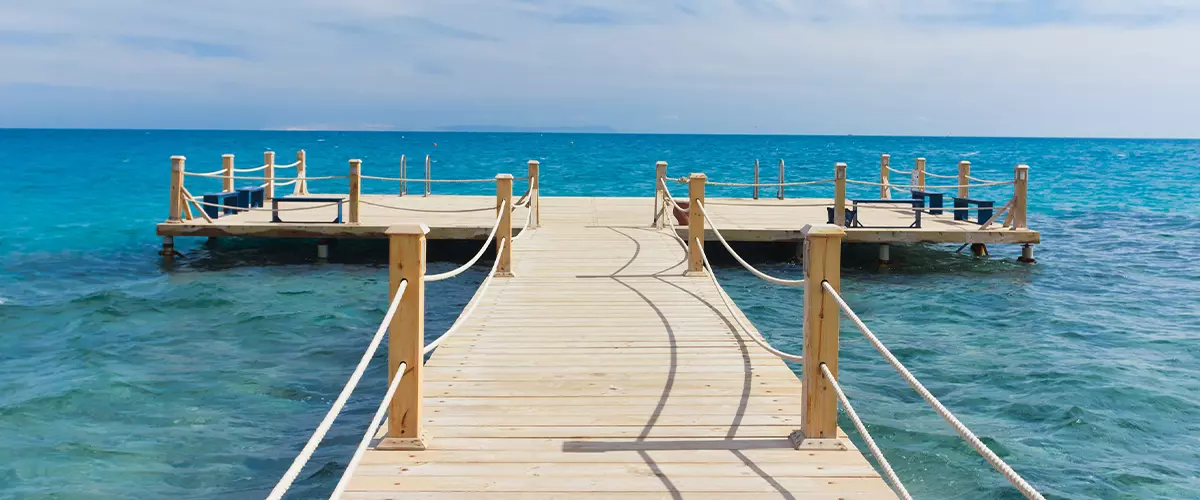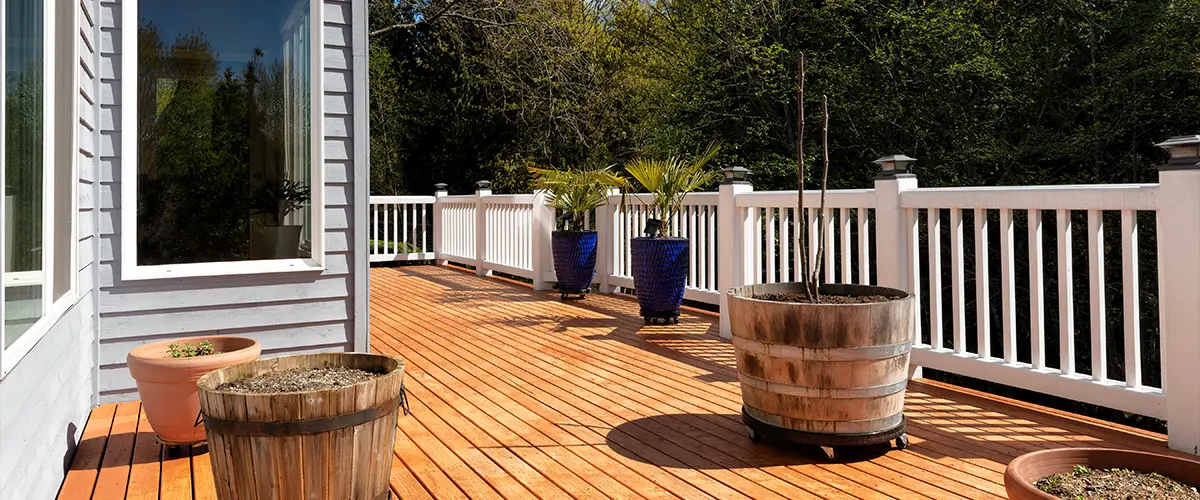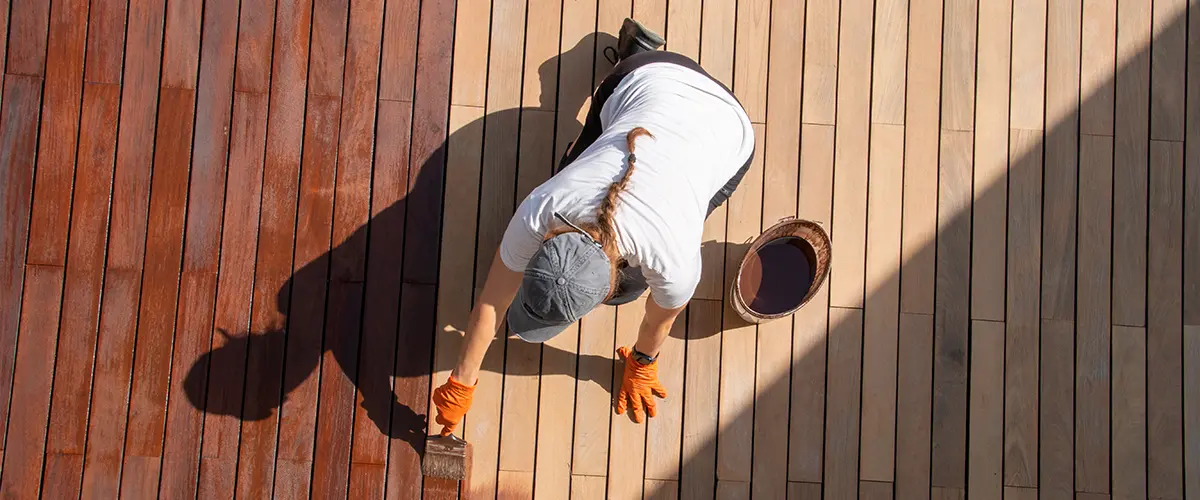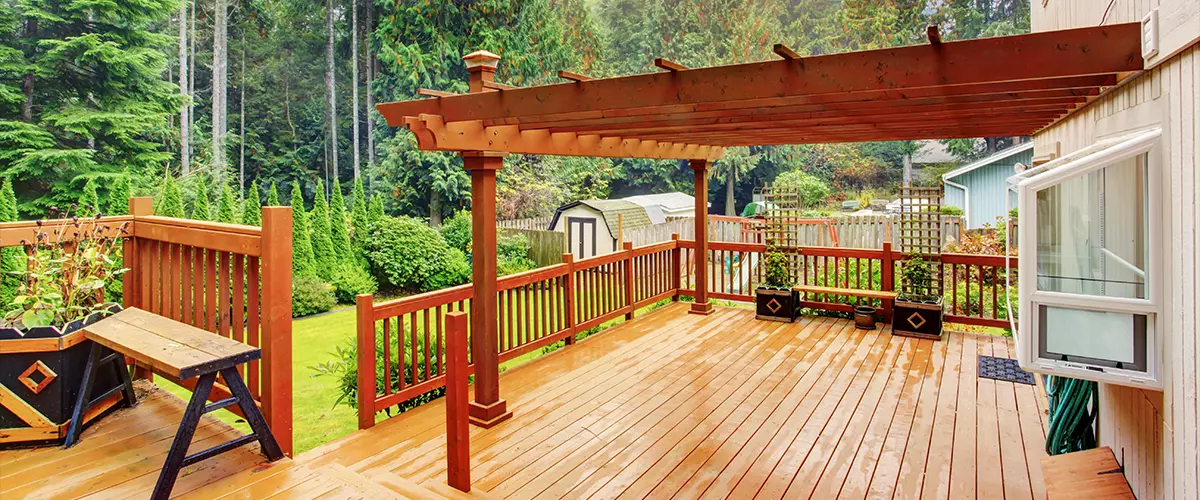Pressure Treated Wood vs. Cedar
When planning a deck for your home in North Carolina, choosing between pressure-treated wood and cedar lumber is a crucial decision that hinges on several factors.
Pressure-treated wood offers an affordable and durable solution, making it ideal for those prioritizing budget and longevity. On the other hand, cedar wood appeals to those who value natural beauty and eco-friendliness, despite potential higher costs and maintenance requirements.
Keep reading to delve into the finer details of pressure-treated wood and cedar lumber!

Pros & Cons of Pressure Treated Wood And Cedar
Understanding Pressure Treated Lumber
Pressure treated lumber is a staple in outdoor construction, renowned for its durability and resistance to the elements.
The process of making pressure treated wood involves infusing the lumber with chemical preservatives under high pressure, which protects it from rot, decay, and termites.
This makes pressure treated wood, including varieties like pressure treated pine, an excellent choice for any outdoor structure, particularly pressure treated fences, where longevity is a priority.
| Pros | Cons |
|---|---|
| Durability: Pressure treated lumber is engineered to withstand the rigors of outdoor use, resisting rot and insect damage. | Chemical Preservatives: Some homeowners are cautious about the use of chemicals in pressure treated wood and their potential impact on the environment. |
| Cost-Effectiveness: Generally, pressure treated wood is less expensive than cedar, making it a budget-friendly option for large projects. | Versatility: Treated lumber can be used for a variety of outdoor projects, from decks to fences, thanks to its robust nature. |
| Modern look: These doors give your bathroom a sleek, contemporary feel. |
Exploring Cedar Lumber
Cedar wood is celebrated for its natural beauty and aromatic scent. Unlike pressure treated lumber, cedar is naturally resistant to rot, decay, and insect damage, thanks to its inherent oils.
This naturally resistant quality means cedar lumber does not require chemical treatment to withstand outdoor conditions, making cedar wood a preferred choice for those seeking an eco-friendlier option.
| Pros | Cons |
|---|---|
| Aesthetic Appeal: Cedar offers a rich, natural look that can enhance the visual appeal of your deck or cedar fence. | Higher Cost: Cedar lumber typically comes at a higher price point than pressure treated wood, reflecting its aesthetic and natural properties. |
| Eco-Friendly: With no need for chemical preservatives, cedar is a more sustainable choice for decking. | Maintenance: To preserve its natural beauty, cedar may require more frequent maintenance, including wood stain applications and sealing. |
| Natural Resistance: Cedar's natural oils provide built-in protection against decay and pests. |
Pressure Treated vs. Cedar: The Decision
The choice between pressure treated and cedar depends on several factors, including budget, maintenance preferences, and environmental considerations.
Pressure treated wood offers an economical and durable solution for those prioritizing cost and longevity. In contrast, cedar wood appeals to those willing to invest in natural beauty and eco-friendliness, despite the potentially higher cost and maintenance requirements.
Ready to make the right choice for your deck project? Contact RaynorShine Construction today, and let our experts guide you towards the perfect solution for your outdoor space! (910) 985-8064

The Environmental Footprint of Decking Materials
Pressure Treated Wood
Pressure treated lumber’s primary environmental concern stems from the chemical preservatives used to extend its life and combat pests. These chemicals, while effective at preventing rot and insect damage, have raised questions about their impact on the environment and human health.
However, advancements in treatment processes have led to the use of less harmful chemicals in recent years. Pressure treated wood is also often sourced from fast-growing, sustainable forests, making it a more renewable resource.
Cedar Wood:
Cedar, on the other hand, is celebrated for its natural resistance to decay and pests without the need for chemical treatment. This makes cedar lumber a more eco-friendly option, as it minimizes the introduction of synthetic substances into your outdoor living space and the environment.
Cedar trees, however, grow more slowly than the varieties typically used for pressure treated wood, which can impact their sustainability as a resource.
Make the right choice for your outdoor oasis. Contact RaynorShine Construction today, and let us help you craft the perfect deck solution for your home! (910) 985-8064
Longevity and Maintenance: Balancing Beauty and Durability
Pressure Treated Wood’s Durability:
With proper maintenance, including regular cleaning, staining, or sealing, pressure treated decks can last 20 years or more. The initial chemical treatment ensures the wood is less susceptible to damage from moisture, rot, and pests, contributing to its longevity.
However, pressure treated wood may show signs of wear, such as splitting or warping, over time.
Cedar Wood’s Natural Longevity:
Cedar’s natural oils provide it with a built-in defense against rot and pests, potentially offering a similar lifespan to pressure treated wood with diligent maintenance.
Cedar requires more frequent maintenance to retain its color and resistance properties, including staining and sealing to prevent fading and moisture damage.
Despite this, cedar’s aesthetic appeal can diminish quicker without consistent upkeep.
Customization and Aesthetic Appeal
Pressure Treated Wood Customization:
While less visually appealing than cedar, pressure treated wood can be stained or painted in a wide range of colors, allowing for significant customization to match any home exterior or landscape design.
Cedar’s Natural Beauty:
Cedar is renowned for its rich color and texture, which can be enhanced with stains and finishes that celebrate its natural grain. Over time, untreated cedar weathers to a silvery-gray, a look that’s highly valued by some homeowners.

Enhancing Outdoor Living: Comfort and Functionality with Pressure Treated vs. Cedar Decks
When embarking on a deck project, homeowners aspire to create an outdoor living space that balances comfort, utility, and style.
This section delves into how pressure treated wood and cedar decks fare for comfort and practicality, ensuring your outdoor space becomes a true extension of your home.
Maximizing Comfort in Outdoor Living Spaces
Pressure Treated Wood:
The practicality of pressure treated lumber extends beyond its structural benefits, offering a solid foundation for a comfortable outdoor area.
Its hardiness supports a variety of features, such as built-in seating, pergolas for shade, and even hot tub installations, without compromising the deck’s integrity.
With appropriate finishing and regular maintenance, pressure treated decks are safe for bare feet, making them a great choice for families looking to enjoy their outdoor space.
Cedar Wood:
Cedar’s natural properties contribute significantly to creating a comfortable outdoor ambiance. Being naturally resistant to rot and insects, cedar decks maintain a smoother surface over time, reducing the risk of splinters.
The wood’s inherent insulation properties also mean it’s cooler to the touch in hot weather compared to pressure treated wood, enhancing comfort during summer months.
Functionality in Deck Design
Pressure Treated Wood:
Functionality is where pressure treated wood truly shines. Its versatility allows for the incorporation of various design elements that extend the deck’s utility beyond a mere outdoor area.
For instance, integrating planters, benches, and storage solutions into the deck design is straightforward, thanks to the material’s adaptability.
Cedar Wood:
Cedar’s visual appeal can transform a basic deck into a luxurious outdoor retreat, perfect for relaxation and entertainment.
Features like cedar railings, trim, and accent pieces can be easily incorporated for a cohesive look, elevating the deck’s functionality by making it a more inviting and enjoyable space.

Crafting Ideal Outdoor Spaces with RaynorShine Construction
The journey to crafting your ideal outdoor living space with RaynorShine Construction involves careful consideration of materials, focusing on how they influence comfort, functionality, and the overall enjoyment of the deck.
Whether you prioritize the robust and versatile nature of pressure treated wood or the aesthetic charm and sensory appeal of cedar, your choice will shape the character and utility of your outdoor sanctuary.
With our commitment to quality and your vision as our guide, RaynorShine is dedicated to transforming your backyard into the ultimate destination for relaxation, entertainment, and cherished moments with loved ones. Contact us today at (910) 985-8064!
